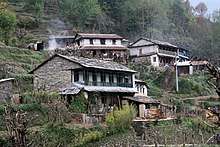Gurung people
The Gurung people, also called Tamu (Nepali गुरूङ), are an ethnic group from different parts of Nepal. They are one of the main Gurkha tribes.[1] They are densely populated in Manang, Mustang, Kaski, Lamjung, Gorkha, Parbat and Syangja district. According to 2011 Census, the total population of Gurung is 522,641.
History
| Languages | |
|---|---|
| Gurung (Tamu kwyi) and Manang language, Nepali | |
| Religion | |
| Majority Buddhism and Hinduism[2] |
Their traditional religious scripture is known as Pye-ta Lhu-ta which contains oral accounts of their traditional history.[3] According to their legend, the Gurung were a wandering tribe that traversed west across Tibet prior to their entry into Mustang. Their Tibetan Sojourn pre-dates the introduction of Buddhism there in the 7th century as the Gurung religious traditions are basically animistic. They celebrate their feasts and festivals and carry out the ceremonies and practices related to worship, birth, death and marriage in accordance with the Bon and Buddhist religion. Losar is the main and biggest festival of Gurung, observed according to the ancient calendar of western Tibet. [4]

Geographical distribution
At the time of the 2011 Nepal census, 522,641 people (2.0% of the population of Nepal) identified as Gurung. The frequency of the Gurung people was higher than national average in the following districts: Manang (52.4%), Lamjung (31.3%), Mustang (21.4%), Gorkha (19.7%), Kaski (16.6%), Tanahun (11.5%), Syangja (9.0%), Dolpa (7.1%), Chitwan (6.8%), Dhading (5.5%), Sankhuwasabha (5.4%), Taplejung (4.6%), Parbat (3.7%), Rasuwa (3.1%), Tehrathum (2.9%), Ilam (2.9%), Kathmandu (2.6%), Nawalparasi (2.4%) and Rupandehi (2.0%).[5]
Religion
Priestly practitioners of the Gurung Dharma include Bon Lam (Lama), Ghyabri (Ghyabring) and Pachyu (Paju).[6] Shamanistic elements among the Gurungs remain strong and most Gurungs often embrace Buddhist and Bön rituals in communal activities.[7][8]
According to the 2011 census, the majority of the Gurungs practise Buddhism (62.72%) also Hinduism (32.18%). However, a small minority practises Bonpo religion (2.32%).
See also
References
- "Ethnohistory of Gurung People" (PDF). Retrieved 5 June 2013.
- Dr. Dilli Ram Dahal (2002-12-30). "Chapter 3. Social composition of the Population: Caste/Ethnicity and Religion in Nepal". Government of Nepal, Central Bureau of Statistics. Retrieved 2013-12-05.
- Macfarlane, Alan. (1992). Gurungs of Nepal : a guide to the Gurungs. Ratna Pustak Bhandar. OCLC 841774183.
- "Indigenous Peoples -Gurung". www.indigenousvoice.com. Retrieved 2020-04-01.
- 2011 Nepal Census, Social Characteristics Tables
- von Fürer-Haimendorf, Christoph (1985). Tribal populations and cultures of the Indian subcontinent. 2. Brill Publishers. pp. 137–8. ISBN 90-04-07120-2. Retrieved 2011-04-02.
- Robert Gordon Latham (1859). Descriptive Ethnology. I. London: John Van Voorst, Paternoster Row. pp. 80–82.
- Mumford, Stanley Royal (1989). Himalayan Dialogue: Tibetan Lamas and Gurung Shamans in Nepal. Madison, Wisconsin: University of Wisconsin Press. pp. 30–32. ISBN 0-299-11984-X.
Further reading
- P. T. Sherpa Kerung, Susan Höivik (2002). Nepal, the Living Heritage: Environment and Culture. University of Michigan: Kathmandu Environmental Education Project.
- William Brook Northey (1998). The Land of the Gurkhas, or, The Himalayan Kingdom of Nepal. Asian Educational Services. ISBN 81-206-1329-5.
- Murārīprasāda Regmī (1990). The Gurungs, Thunder of Himal: A Cross Cultural Study of a Nepalese Ethnic Group. University of Michigan: Nirala Publications.
External links
- Gurung, Harka (1996-01-10). "Ethnic Demography of Nepal". Nepal Democracy. Archived from the original on 2011-04-17. Retrieved 2011-04-03.
- "Gurung". Britannica Student Encyclopedia online. Encyclopædia Britannica. Retrieved 2011-04-03.